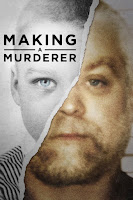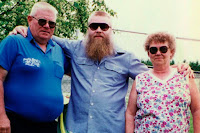 Making A Murderer is a 10-part US documentary series about a miscarriage of justice. It's directed by film school graduates Laura Ricciardi and Moira Demos, who also did camera and sound.
Making A Murderer is a 10-part US documentary series about a miscarriage of justice. It's directed by film school graduates Laura Ricciardi and Moira Demos, who also did camera and sound.The series took 10 years to film, producing over 700 hrs of footage.
Even though it is a became a huge success on Netflix it was turned down by HBO and PBS.
What is documentary?
Documentary in purest sense is filmed observation. A recording or 'document' of reality. Primary for informing rather than escapist entertainment.
Scottish filmmaker John Grierson described documentary as "the creative treatment of actuality."
How it's different from Dramatic Film:
Documentary
- Unscripted (but often relies on classic narrative structure)
- Employ real people, but often requires a directed 'performance' element)
- Typically shot handheld (but often employs classical fixed camera techniques)
- Does not use formal Hollywood mise en scene (but still relies on classical precepts of framing, composition and lighting)
Dramatic Film
- Narrative/dialogue-driven (but can be improvised)
- Performance-led by professional actors (but can employ non-actors and improvisation)
- Typically employs classical Hollywood camera techniques (but can use documentary 'verite' style)
- Uses foral Hollywood Mise en scéne and often studio sets (but can opt for documentary style of 'real' locations and natural lighting)
"Documentary film is traditionally perceived to be the hybrid offspring of a perennial struggle between the forces of objectivity (represented by the 'documents' or facts that underpin it) and the forces of subjectivity (that is the translation of those facts into representational form. - Stella Bruzzi, New Documentary, 2006
Documentary formats
Formal documentary:
-Observational (Excluded)
-Current affairs/factual (Making a murderer; content driven)
-Polemic (Adam Curtis)
Uses documentary form, techniques & conventions to educate, debate and inform content.
Hybrid Documentary
Reality (Benefits Street)
Scripted reality (TOWIE)
Drama-documentary (Man on wire, touching the Void)
Uses documentary form, techniques & conventions, but primary for entertainment content.
Narrative documentary modes:
Expository - emphasises rhetoric and information. The classic 'voice of God'/current affairs/BBC documentary.
Observational - classic 'fly on the wall'. Typically no voiceover, music or other interventions (Maysles Brothers).
Participatory - onscreen relationship between filmmaker and subject, usually via interview (Louis Theroux)
Reflexive - makes viewer aware of filmmaking process. Seeks to challenge our assumptions (Nick Broomfield).
Poetic - artistic montage-based. Rely on expressive editing of sound and image rather than classical continuity (Adam Curtis).
Performative - filmmaker/subject conveys personal experience (Michael Moore).
Making A Murderer - Content
- Objective expository mode - retelling of historical story.
- Subject relies heavily on evidentiary support (graphic and visual archive, interview)
 Subjective tension in aesthetic approach
Subjective tension in aesthetic approach- Use of 'reconstruction' - beach POV sequence, crime re-enactment through graphic montage.
- Use of music - decried by 'pure documentary' advocates as emotional manipulation.
Making A Murderer - Context
- Formal realist approach to location filming (real people in real places), but mediates story through stylised montage sequences and music.
- Conventional representation of contributors in work or home environments.
- Filmmakers avoid polemic, but accused of bias in not including some participants and facts/evidence. They assert series is "thorough, accurate and fair".
Critical approaches to documentary
Realism:
- The presentation of art as simulacrum of world as exists: in documentary through unintrusive filming (handheld, natural lighting, no music, etc). Used to convey notions of authenticity, truth ad representation.
- Key tenet of observational mode ('fly on the wall', cinéma vérité, Direct Cinema): documentary is about capturing and showing 'real life' as it happens.
- -Antithesis of 'reality television' which uses similar techniques and conventions, but is for entertainment rather than polemic.
Mediation & Representation
- What we see is NOT objective reality or truth, but firstly the filmmaker's version: what they have mediated.
- The process of mediation - the editorial decision-making process - directly affects. Representation: through judgement and selection editorialises how gender, race and class are presented.
- We as the audience are also complicit in mediation, through our understanding and reading of media texts (semiotics, ideology).
Reception Theory
- How we as the audience mediate texts, and factors that might influence us.
- Argues cultural text has no inherent meaning in and of itself. Instead, meaning is created as the viewer watches and processes the film.
- Factors include elements of the viewer's personal identity, the exhibition environment, and preconceived notions of programme's genre and production.
Ideology
- A set of opinions, values, beliefs and assumptions that one uses to think about and relate to the world.
- Ideology influences both the context in which the documentary is produced and how it is received.
- Ideology is commonly represented in documentary and factual television through political bias ('liberal left-wing agenda', Marxist and Nazi propaganda).
Louis' Useful Questions To Think About":
- Representation - how social class is utilised and depicted in Benefits Street and The Only Way Is Essex. Who control representation? How are participants mediated.
- Dramatisation - is any form of reconstruction or enactment simply a stylistic device? Or does it
//All images from Google.com\\












